My Life as a Nerd
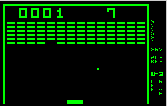 In early 1981, some mysterious machines appeared, temporarily set up in
a physics lab at my high school. They were all running a game I had
never seen before called "Breakout."
In early 1981, some mysterious machines appeared, temporarily set up in
a physics lab at my high school. They were all running a game I had
never seen before called "Breakout."
A short time later, I saw a BASIC program in a sidebar in the
math textbook, illustrating how one might use a computer to solve the
problem at hand. I asked the teacher, Mr. Barrett, whether this would
work on these computers. Being the progressive teacher that he was
he said "Probably. Why don't you go and try it?" What, right now
in the middle of the class period? Sure. So I went and typed the
program in and it worked, and I was hooked.
All social pressures of high school -- what to do with yourself during
the breaks, who to sit with in the cafeteria, agonizing over why the
girls ignored you -- disappeared in short order. I stopped eating lunch
at school altogether so as not to miss out on precious computer time.
In the small clique of the computer room I was not an outcast.
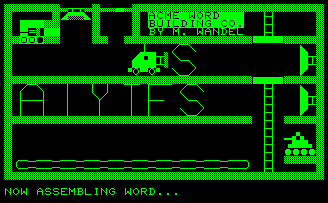 Gradually I mastered the BASIC language, then assembly. Government
job creation led to summer employment in 1983-1985 where we did stuff
like write educational programs like this one. Click on the picture
to download it so you can try it under
VICE, the Commodore emulator.
Gradually I mastered the BASIC language, then assembly. Government
job creation led to summer employment in 1983-1985 where we did stuff
like write educational programs like this one. Click on the picture
to download it so you can try it under
VICE, the Commodore emulator.
In March 1984 I spent most of my savings on a Commodore 64 computer.
Programming tools for that machine were plentiful, but it was always
more fun to write your own. All my good ones are on these disk images.
There's a Tetris game too.
 My brother Matthias built a very primitve
drum scanner out of Fischer
Technik, later I built one out of other junk, and we used them to
digitize pictures like this. I figure we got a usable resolution of
10dpi with 4 levels of brightness.
My brother Matthias built a very primitve
drum scanner out of Fischer
Technik, later I built one out of other junk, and we used them to
digitize pictures like this. I figure we got a usable resolution of
10dpi with 4 levels of brightness.
Here is a cartoon I drew about computers
in that time period.
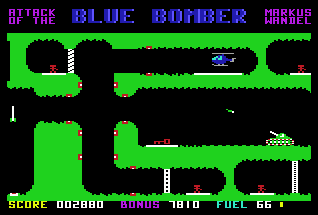 I wanted to be a programmer just as good as the pros, and because
most of the professional product we saw was video games, and because
one of the better ones was "Fort Apocalypse" I just had to write my
own smooth scrolling helicopter-in-a-dungeon game. Looking back
at it now it is unimaginative but it plays OK, click on the image
to download a disk image to try it on an emulator. The only thing
missing is the second half of the third level, the dungeon simply
ends and you fly out into black nothingness. If anyone cares, the
source code and the cobbled-together tools used to make this game
are all on the disk image too.
I wanted to be a programmer just as good as the pros, and because
most of the professional product we saw was video games, and because
one of the better ones was "Fort Apocalypse" I just had to write my
own smooth scrolling helicopter-in-a-dungeon game. Looking back
at it now it is unimaginative but it plays OK, click on the image
to download a disk image to try it on an emulator. The only thing
missing is the second half of the third level, the dungeon simply
ends and you fly out into black nothingness. If anyone cares, the
source code and the cobbled-together tools used to make this game
are all on the disk image too.
In fall 1985 I went to university. In summer 1987 I bought a secondhand
Intertec Superbrain (actually a Compustar, the network version of
the Superbrain) for $200. This was a CP/M machine with a Z80 processor,
64K of RAM, and two 360K floppy drives. I rewired the network port to
make it into a parallel printer port, hacked a strange APL interpreter
that I found on a BBS to correctly display the APL character set
(using a custom character ROM.) Using the primitive subset of C implemented
by the BDS C compiler, I wrote a program to read files off MS-DOS floppies.
I wrote a nice terminal emulator for it so it could be used to access
Unix machines remotely. I had vague plans to port CP/M Plus, the much more
advanced version of CP/M that came with the Commodore 128, to the machine
but they never went anywhere.
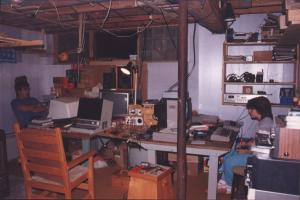 I really like the picture on the left,
which Matthias took while I was at home over Christmas 1987. That's
me with the Superbrain on the left, then the antique Volker-Craig 303
terminal that I had earlier bought to use with my 300-baud modem. On the
right is my sister Marlene playing a game on the 64.
I really like the picture on the left,
which Matthias took while I was at home over Christmas 1987. That's
me with the Superbrain on the left, then the antique Volker-Craig 303
terminal that I had earlier bought to use with my 300-baud modem. On the
right is my sister Marlene playing a game on the 64.
In early 1988 I bought a secondhand Amiga 1000.
The Amiga soon acquired 1MB of memory, a homebrew SCSI interface, an 80MB
hard disk and a QIC-24 tape drive, all with homemade device drivers. You can't
imagine the feeling, dumping the OS onto the hard disk after a marathon 18-hour
hacking session, after trying to do serious computing on a primitive single-floppy computer for a year,
and knowing you can kiss that awful gronking noise goodbye for good. I brought the
system up hard-disk-based as soon as I could, then worked the last bugs out of
the device driver. The machine's performance went up twentyfold. That was sweet.
Buying it with a hard disk from the start would have been no comparison.
I never did any graphics programming on the Amiga so I have no pictures to show.
The only thing of any consequence that I did was reverse-engineer the operating system
kernel and release a commented disassembly, however because of copyright restrictions
you actually had to run a program to reconstruct it using data from your own
machine's ROM, and who has that any more. You can find it on Fred Fish disk #188.
I had discovered Unix and C (on a Sun 3/160) on a co-op work term in the fall
of 1987 and forever after wanted my home machine to be just like
Unix. On the Amiga I had unix-like commands and the ability to
read and write tar tapes in the same format as the Unix machines
I had access to.
In 1992 I found a NABU 1600 computer at a garage sale. It cost $40 and the sturdy
metal enclosures looked useful. When I got it home I plugged all the pieces
together and turned it on and it booted and said "login:" Whoa. Can anyone
still remember what magic that little prompt represented, what worlds of interesting
computing it was the key to, in those days before cheap 32-bit PC clones and
Linux, when the word "internet" went hand in hand with "Unix box" and there
wasn't much access to either?
Fortunately there was no root password.
This was an early Unix micro made right here in Ottawa in 1982-83.
It had an 8086 processor, a discrete-logic paging MMU, 512KB of main memory,
a 10MB hard disk, a 500KB floppy drive, and 4 serial ports for terminals and
printers. No other I/O. It ran Microsoft Xenix 1.0 which was so direct a
port of Bell Labs 7th Edition Unix that they had actually forgotten to white-out
one reference to the PDP11 in the manuals. It was the closest thing to
a classic Unix machine you could get without actually owning a PDP11.
It was astounding how elegant and simple an operating system Unix was before all
the SunOS-style bloat hit. On the other hand almost everything I was
accustomed to using did not exist. No C-shell, no vi editor, no networking,
no soft links, no really long filenames. Still, playing around with this machine and transferring the
OS over to a bigger hard disk greatly enhanced my understanding of Unix.
Programs on this machine (and on the PDP11 too) could have at most 64K bytes
of code and 64K bytes of data. I was able to get a vi clone going by
configuring it for Minix, a "toy" Unix for PCs that had pretty much the same
limitations as the grown-up Unix of a decade earlier. In the stripped-down
Minix configuration it had 63 kilobytes of code.
For a number of years most home computing I did was via dialup
from a VT320 terminal to a Unix machine at work
although I did maintain records and do cross-development for my 8031 projects
on the Amiga, which remained at OS 1.3 and had no software newer than about 1990 on it.
I didn't buy a new primary computer until early 1999, when I finally
bought a serious PC clone to run Linux on.
Finally, real Unix at home.
Update: April 24, 1999.
The Amiga has been retired. For 11 years it was the home of my collected
digital bits. By the end it had a 573MB 5.25" full-height hard disk
and a QIC-150 tape drive, and stored a whole decade's worth of email, letters
and code. Quite a job for a 7MHz 68000 machine. You get
attached to a machine when you've patched the operating system to boot
your homemade device driver to access a scrounged disk through homemade
hardware. When you've low-level formatted the disk by typing SCSI command
bytes in hex into a homemade SCSI exerciser program with the official
SCSI specification as your manual. When you still remember how cool it was
that the homemade TAPE: device actually worked better than /dev/rst0 on
the Unix boxes.
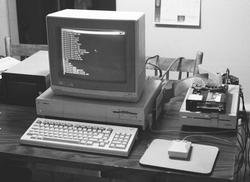 I had a whole drawer full of backup tapes, not one of which I'd ever had
to restore. The retirement ceremonies included going through another whole
drawer full of floppy disks
and the whole hard disk, saving the good bits and deleting the private
ones. Nostalgia struck me. There were files that I hadn't looked at since
they were unspeakably sophisticated, and now it was all primitive. I still
had the "King Tut" picture and the "Jay's Song" music that had awed the
crowds at the 1988 World of Commodore show.
I had a whole drawer full of backup tapes, not one of which I'd ever had
to restore. The retirement ceremonies included going through another whole
drawer full of floppy disks
and the whole hard disk, saving the good bits and deleting the private
ones. Nostalgia struck me. There were files that I hadn't looked at since
they were unspeakably sophisticated, and now it was all primitive. I still
had the "King Tut" picture and the "Jay's Song" music that had awed the
crowds at the 1988 World of Commodore show.
I found more than one hacking project I'd forgotten about altogether.
I still had early debug versions of the device drivers. All obsolete now.
After I'd moved the files to the Linux box, I compiled the 8031 assembler
and ran my PBX source code through it. On the Amiga there had been time to get
something from the fridge while it assembled. On the PC, whose CPU
technology is about 15 years newer, it takes 90 milliseconds.
With Linux I can plug in any old tape drive and it just works, no scratching
my head over how I'm going to eliminate another two clock cycles from the
byte transfer loop so the damn thing will stream. I've never even looked
at the SCSI code and I don't care.
Fortunately for the Amiga, it is spared the indignity of a dusty attic or
a dumpster. A friend who loves old computers and used to hack Amigas too
was very happy to get it and for a while at least, it will be used again.
Ridiculous. I'm talking about this thing as if it were a beloved old dog
I had to find a new home for. Can't help being a nerd, I guess.
Update: March 6, 2000.
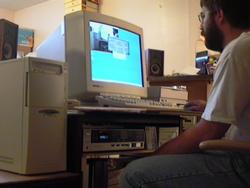 In the past year I've spent more of my spare time staring into a computer
CRT than ever before in my life. Linux and a fulltime internet connection
(a Nortel 1-meg modem provided by my employer)
can do that to you. My attention span for this sort of thing is two years
so perhaps a year from now I can start doing other stuff again.
In the past year I've spent more of my spare time staring into a computer
CRT than ever before in my life. Linux and a fulltime internet connection
(a Nortel 1-meg modem provided by my employer)
can do that to you. My attention span for this sort of thing is two years
so perhaps a year from now I can start doing other stuff again.
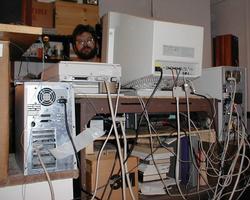 Meanwhile there are four Linux machines in the house, ranging from my main
PC to a lowly 486 that is my internet gateway machine. I've learned a lot
about Unix and networking. I can even write real Unix programs now, the
kind where the whole program is wrapped around a select() system call.
Meanwhile there are four Linux machines in the house, ranging from my main
PC to a lowly 486 that is my internet gateway machine. I've learned a lot
about Unix and networking. I can even write real Unix programs now, the
kind where the whole program is wrapped around a select() system call.
I sometimes wonder why I still design hardware for a living when this stuff
is so much more interesting. But hardware design pays better, and besides
this stuff probably wouldn't be fun if it was a job rather than a hobby.
Update: March 29, 2003.
My big tech project in the last few months has been the new web server.
I lucked into access to a good bandwidth DSL uplink at a friend's house
where I could park a server, so now I can host as many gigabytes of stuff
as I want and nobody superimposes pesky ads over my pages, and I can have
my own domain name. I took the hit once, getting Google to learn where
all my stuff was again, now I plan to keep wandel.ca
regardless where I host it. I like being the king of Google on certain
obscure subjects
and you can only be that if you don't change your URL all the time.
Isn't it strange how you always feel nostalgia for the stuff you're not
currently doing? When I'm deep into some computer nerd thing, holed up in the
basement for weeks on end, I feel that
I'm missing out on real life. As I get older, I place more and more emphasis
on the real life stuff and end up not doing any technical
projects for so long that I come across some and they feel like ancient
history, like a part of me that has been lost.
I did a long overdue basement cleanup. The first step was to build a huge
sturdy shelf structure in the laundry room, where I could file cardboard
boxes full of stuff too good to throw out. Then I basically went through
every box of junk I have and sorted. And came across design notes and
actual artifacts from all kinds of stuff I used to do.
Nostalgia struck me, even for my Amiga stuff.
I find that the permanent cure for such a nostalgia attack is to take everything
I can still find or remember about an old project or event, and document it on
the web. Then there is a "checkpoint" - no faint memories getting ever
dimmer but good solid fact that I can always refer to. And I can add it as
search engine fodder to my web page - my contribution to the information
universe may be humble, but at least I have some.
Another nostalgia cure is the wonderful world of emulators. Using
UAE I can boot my old Amiga
environment right up, ditto with VICE
for the Commodore 64 stuff. Again, the past is right at your fingertips, so there's
not such a tendency to romanticize it, and you don't have to keep a basement
full of actual flakey hardware.
In a way, I'm doing the same thing with my non-technical life by accumulating a
huge number (29,000 and counting) of well-organized photos, old ones scanned and
new ones digital.
That's a whole other project, but I can't put that on my web site, some of it
is too personal (if you can believe that).
Home
 Gradually I mastered the BASIC language, then assembly. Government
job creation led to summer employment in 1983-1985 where we did stuff
like write educational programs like this one. Click on the picture
to download it so you can try it under
VICE, the Commodore emulator.
Gradually I mastered the BASIC language, then assembly. Government
job creation led to summer employment in 1983-1985 where we did stuff
like write educational programs like this one. Click on the picture
to download it so you can try it under
VICE, the Commodore emulator. In early 1981, some mysterious machines appeared, temporarily set up in
a physics lab at my high school. They were all running a game I had
never seen before called "Breakout."
In early 1981, some mysterious machines appeared, temporarily set up in
a physics lab at my high school. They were all running a game I had
never seen before called "Breakout."




 In the past year I've spent more of my spare time staring into a computer
CRT than ever before in my life. Linux and a fulltime internet connection
(a Nortel 1-meg modem provided by my employer)
can do that to you. My attention span for this sort of thing is two years
so perhaps a year from now I can start doing other stuff again.
In the past year I've spent more of my spare time staring into a computer
CRT than ever before in my life. Linux and a fulltime internet connection
(a Nortel 1-meg modem provided by my employer)
can do that to you. My attention span for this sort of thing is two years
so perhaps a year from now I can start doing other stuff again.